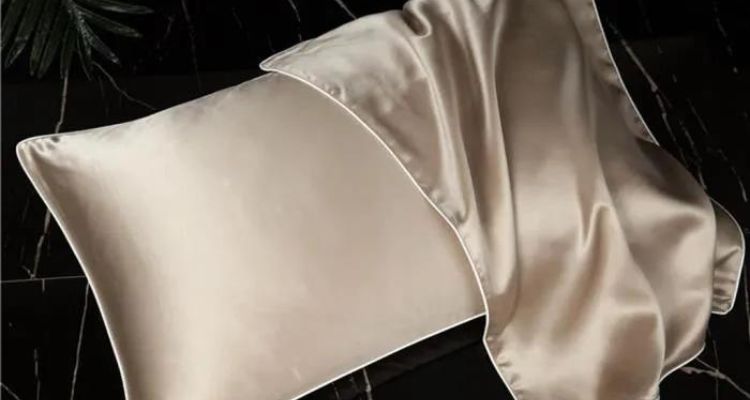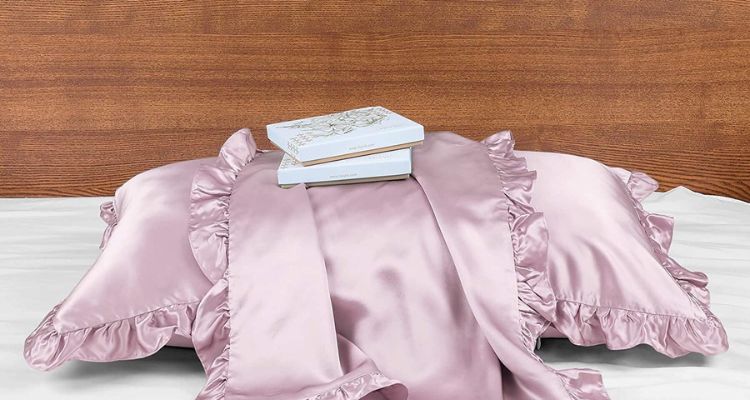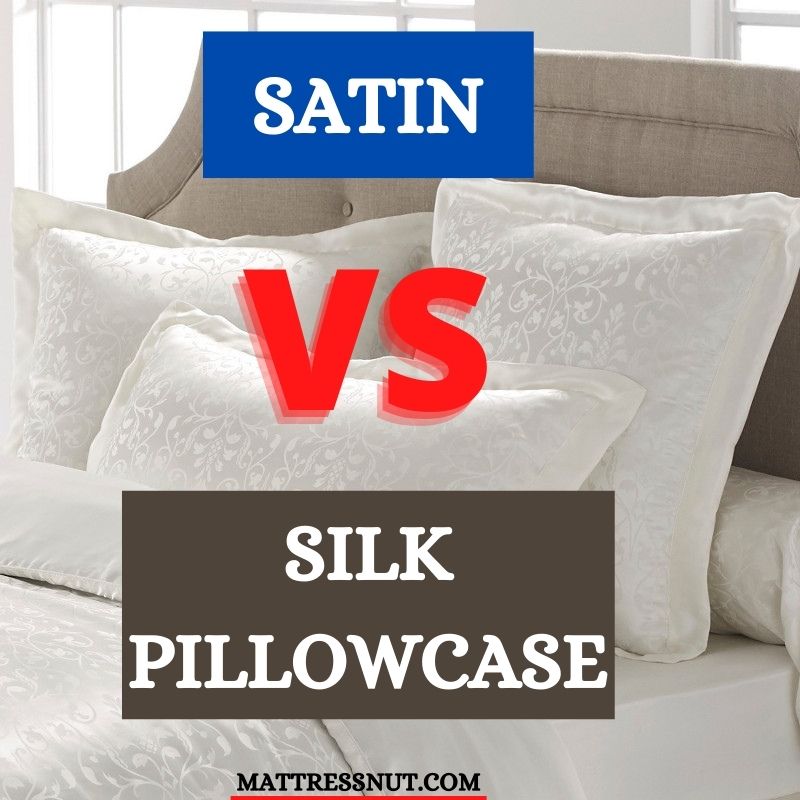Whether you are a fan of cotton filling or prefer to fill your pillows with polyester, there is no denying using the right pillow is critical to your sleep. But most people overlook the materials for their pillowcases because they are too indulged in the filling.
Satin and silk are two of the most popular materials for pillowcases. By and large, they both deliver the same level of comfort; however, they both are pretty different.
In this guide, we will discuss the differences between these two materials and the pros and cons they offer if you use them as pillowcases.
Read on to find which one of these two is an ideal option for you to choose.
What’s Silk?
Many decades ago, China started domesticating silkworms to produce silk. It develops by interweaving several threads and developing clothes, banners, and screens.

Over time, more production and development methods were introduced, and with the ever-increasing demand, silk spread across the world with the expanding trade routes back then.
Real silk was considered a high-end product back then and now because it has an unmatchable smooth feel. But these days, silk is not limited to the upper class of society.
Benefits of Silk Pillowcases
Most of the benefits that silk offers to stem from it being a natural material. So here are some of the benefits that silk has to offer.
Silk ensures bedtime breathability
There is a wide range of methods that you can use to stay cool at night. But flipping your pillow multiple times through the night can be irksome. So, silk solves those problems, and it does so by boosting better air circulation with its airy threads.
No nasties
This material is highly hypoallergenic, so you won’t have to deal with mold, mildew, or dust mites. But that doesn’t mean you should ignore your pillowcase hygiene and care. But you must remember that silk tends to shrink, so dry-cleaning is the only option.
Malleable and strong
The threads in silk tend to hold better even if the material seems so delicate as they come out of the spinneret. The good thing is that you don’t have to compromise on flexibility for this strength. Therefore, your pillowcases will hold up pretty well.
Less frizz, less friction
As silk is pretty smooth, it won’t cause friction upon coming in contact with your hair strands. And it doesn’t matter what your hair type is. Therefore, you won’t have to worry about hair loss or similar issues.
Less absorbent
We are not saying that you should completely forget your nighttime skin routine. But silk is less absorbent compared to other materials. Therefore, it won’t hold any oils for your skin throughout your snooze time.
Can be organic
Some silk variants are organic, meaning the production doesn’t have pesticides or harmful chemicals. So, you won’t have to worry about that during your sleep, as your pillowcase will be squeaky clean.
Cons of silk pillowcases
- Silk is one of the most expensive bedding materials.
- Besides, if you are environmentally friendly or vegan, remember that silk is not any of these. The production process of silk kills silkworms most of the time.
- You cannot machine wash silk fabric directly. Dry cleaning is the only way out.
What’s Satin?
Unlike silk, satin is not a material that can be woven into a fabric because it’s a weave with a single-sided sheen. Now, there are various versions of satin available on the market.
However, the two primary types are twill and plain. Satin was woven with silk back in the day. But modern variants go with a wide range of other materials, most of which are synthetic.
- Rayon
- Cotton
- Acetate
- Polyester
Compared to the intensive production methods used to make silk, satin is much cheaper to produce, and hence it is a cheaper alternative to silk. In addition, satin is much simpler to imitate and has a close variant called sateen woven with much shorter fibers.
Benefits of Satin Pillowcases
Satin comes with its own unique set of boons, and we list them as follows:
Top-notch smoothness
Satin can be developed using a mix of different materials. Therefore, manufacturers can make it even silkier than real silk. That’s extraordinary if you compare the legacies of both these materials.
Better hair and skin
If you are looking for materials that are good for your skin and hair, you can go for satin or silk. Satin has the same benefit that silk offers, and that is low friction. Moreover, satin is hypoallergenic and breathable, just like silk too.
An affordable luxury
As you can see, satin has all the pros that silk offers. But the best part is that it comes with a much cheaper price tag.
Quick Clean
Silk might be strong and durable but will not hold up in a wash; you must dry clean it. But that is not the case with satin. So, you can wash it using those cold cycles and throw it in with other fabrics too.
Availability
Satin is much easier and quicker to produce because there are no silkworms to harvest. So, there is a wide variety of options available across the globe.
Cons of a Satin Pillowcase
Satin is a good replacement for silk, but it has drawbacks.
- In comparison to silk, satin is much more vulnerable.
- Satin is not breathable because it is developed using synthetic fiber. So, it is not an ideal option for anyone dealing with skin allergies or asthma.
- Satin is more prone to mold, mildew, and dust mites.
- Since it is made of synthetic materials, satin does feel artificial and cold.
Which Is Better: Silk or Satin Pillowcases?
After reviewing the overviews, pros, and cons of both these materials, let’s compare which is better.

Luxurious – Silk is Winner
There is a clear winner here between the two: silk. Silk feels soft and smooth, and the luxuriousness of the fabric is pretty obvious before the first site.
Satin feels nice and soft; some variants are even smoother than silk. But being made of synthetic materials, it has that artificial look and feel. So, silk is a much better option to give your bedroom a luxurious feel (also check the top rated luxurious beds).
Comfort – Here’s a Tie
In terms of comfort, the match-up between silk and satin is pretty much tied. Both these materials feel pretty smooth and soft. They are excellent for your hair and skin because they do not cause friction.
But you must notice that silk feels warmer because it develops from natural materials. On the other hand, satin feels colder because of synthetic materials. So, we would say that silk has a slight upper hand here.
Price – Satin is Winner
Without a doubt, satin is a winner here because it develops using synthetic materials. However, the production process of silk is pretty hefty; silkworms are grown, which takes time.
The production process of satin doesn’t take much time, and satin is not difficult to imitate. That is why satin is much cheaper, and many options are available. But that is not the case with silk, so it comes with a heftier price tag.
Breathability – Silk is Winner
Again, silk will win this round because silk is made of natural materials. It boosts air circulation, which is why it is an ideal option for anyone dealing with skin allergies or asthma.
On the other hand, satin is developed from synthetic materials, so breathability will always be an issue here. Therefore, this is not the right option for anyone dealing with allergies or bugs.
It means that satin is more prone to mold and mildew than silk. Silk doesn’t allow mold or mildew growth or development because it is highly breathable.
Hypoallergenic – Silk is Winner
This one is pretty obvious because breathable materials are mostly hypoallergenic too. So, silk turns out to be the winner here as well. With better air circulation and breathability, silk is a better option for hypoallergenic traits.
On the other hand, synthetic materials like satin are not that great regarding hypoallergenic features. These materials don’t allow much airflow and are more prone to developing bacteria, mold, and mildew.
Hair care – Satin is Winner
Of course, you will put your head on your pillowcase, and if it is not of soft quality materials, your skin and hair will have to deal with a lot of friction. This can cause acne on your skin and hair loss.
Therefore, you should consider using softer materials that don’t cause friction. It is soft to the touch and feels, and it will not cause any damage to your skin and hair in the long run.
Satin is pretty smooth and soft to feel. Some variants of satin can be even smoother and softer than silk too. So, satin has a slight upper hand here over silk. But they both work pretty well in this scenario.
Key Takeaways: Satin Vs Silk Pillowcase
Understanding Silk and Its Benefits
Originating from China, silk has been a revered material for many centuries, primarily due to its unmatched smooth feel. Today, it is not just reserved for the elite. Its benefits include offering bedtime breathability, being hypoallergenic, possessing strength despite its delicate feel, causing less friction which is great for hair health, being less absorbent ensuring skin products remain effective, and some variants being organically produced without harmful chemicals.
The Downside of Silk
While luxurious, silk pillowcases can be expensive and are not always considered environmentally friendly or vegan due to the silkworms often being killed in the production process. Moreover, silk pillowcases require dry cleaning for maintenance.
Understanding Satin and Its Advantages
Satin, unlike silk, is a weave and not a natural material. It has had its roots in being woven with silk but now predominantly utilizes synthetic materials, making it more affordable. Some benefits of satin include its exceptional smoothness which can sometimes surpass silk, its hypoallergenic and breathable nature, and easy maintenance as it can be machine washed.
The Limitations of Satin
Though satin can be seen as a silk alternative, it is generally more fragile, less breathable due to its synthetic nature, and is prone to issues like mold and mildew. It also has a distinct, colder feel compared to silk.
Comparative Analysis: Silk vs Satin
When it comes to luxury, silk is unparalleled. However, both materials are comparable in terms of comfort. Satin takes the lead in affordability, while silk outperforms satin in breathability and hypoallergenic properties. For hair care, satin may slightly edge out due to some variants being smoother than silk.
Conclusion:
Both silk and satin have their benefits and shortcomings. While silk offers better quality, breathability, and hypoallergenic features, it is much more expensive, harmful to the environment, and tough to maintain.
On the other hand, satin might be of synthetics, but its variants can be much softer than silk and are much cheaper and readily available.
So, which one are you going to go for?
References:
https://www.yad-efraim.org/benefits-of-silk-bedding/
https://www.worldhistory.org/Silk/
https://kinapparel.org/pages/why-satin
Satin vs Silk pillowcase FAQs
Is a satin or silk pillowcase better for the skin?
In terms of softness and smoothness, both silk and satin work great. But silk is more hypoallergenic and breathable than satin. This is because silk is made of natural materials, while satin is made of synthetic materials.
Are satin pillowcases as good as silk pillowcases?
No, silk is made of natural materials; it is soft, smooth, and warm. It is highly breathable and hypoallergenic too.
Satin is made of synthetic materials and is neither breathable nor hypoallergenic. It might touch and feel soft, and some variants can be much softer than silk, but silk is a high-end product, and satin cannot replace it.
However, satin is cheaper, more durable, and available in various colors and textures. So, both satin and silk have their advantages and drawbacks.
Is silk better than satin?
It entirely depends on what you are looking to achieve. If you are talking about quality, silk is better and comes with a bigger price tag. If you want durability and value for money, satin is better. It is up to you to decide based on your preferences.
Why is satin cheaper than silk?
Satin is cheaper than silk because it develops using synthetic materials. That is where you will also find a wide range of colors and textures available in satin. On the other hand, silk is made of natural materials, and its production process is much more time-consuming and hectic.
Why is silk more expensive than satin?
Again, silk is expensive because it comes from silkworms. Growing these worms is time-consuming; extracting silk from them isn’t a simple task either. That is why silk is much more expensive.

